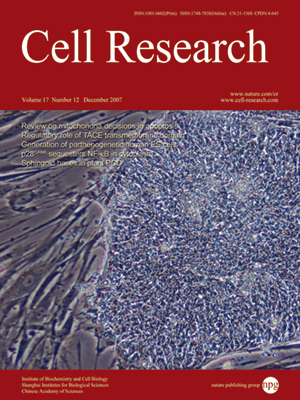
Volume 17, No 12, Dec 2007
ISSN: 1001-0602
EISSN: 1748-7838 2018
impact factor 17.848*
(Clarivate Analytics, 2019)
Volume 17 Issue 12, December 2007: 999-1007
ORIGINAL ARTICLES
A highly homozygous and parthenogenetic human embryonic stem cell line derived from a one-pronuclear oocyte following in vitro fertilization procedure
Ge Lin1,2,*, Qi OuYang1,2,*, Xiaoying Zhou1,2, Yifan Gu1,2, Ding Yuan1,2, Wen Li1,2, Gang Liu1,2, Tiancheng Liu1,2 and Guangxiu Lu1,2
1Institute of Reproductive and Stem Cell Engineering, Central South University, Changsha 410078, China
2National Engineering and Research Center of Human Stem Cell, Changsha 410078, China
Correspondence: Guangxiu Lu,(lugxdirector@yahoo.com.cn)
Homozygous human embryonic stem cells (hESCs) are thought to be better cell sources for hESC banking because their human leukocyte antigen (HLA) haplotype would strongly increase the degree of matching for certain populations with relatively smaller cohorts of cell lines. Homozygous hESCs can be generated from parthenogenetic embryos, but only heterozygous hESCs have been established using the current strategy to artificially activate the oocyte without second polar body extrusion. Here we report the first successful derivation of a human homozygous ESC line (chHES-32) from a one-pronuclear oocyte following routine in vitro fertilization treatment. chHES-32 cells express common markers and genes with normal hESCs. They have been propagated in an undifferentiated state for more than a year (>P50) and have maintained a stable karyotype of 46, XX. When differentiated in vivo and in vitro, chHES-32 cells can form derivatives from all three embryonic germ layers. The almost undetectable expression of five paternally expressed imprinted genes and their HLA genotype identical to the oocyte donor indicated their parthenogenetic origin. Using genome-wide single-nucleotide polymorphism analysis and DNA fingerprinting, the homozygosity of chHES-32 cells was further confirmed. The results indicated that 'unwanted' one-pronuclear oocytes might be a potential source for human homozygous and parthenogenetic ESCs, and suggested an alternative strategy for obtaining homozygous hESC lines from parthenogenetic haploid oocytes.
Cell Research (2007) 17: 999-1007. doi: 10.1038/cr.2007.97; published online 27 November 2007
FULL TEXT | PDF
Browse 1815


